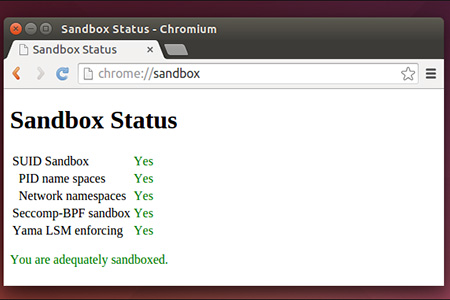 Operation and Maintenance
Operation and Maintenance
 Linux Operation and Maintenance
Linux Operation and Maintenance
 What are the differences between Chromium and Chrome?
What are the differences between Chromium and Chrome?
What are the differences between Chromium and Chrome?
Chromium is an open source browser project that forms the basis of the Chrome web browser.

When Google first launched Chrome in 2008, they also released the Chromium source code for Chrome as an open source project. The open source code is maintained by the Chromium project, while Chrome itself is maintained by Google.
The biggest difference between the two browsers is that although Chrome is based on Chromium, Google has also added many proprietary features to Chrome, such as automatic updates and support for other video formats. Google has also taken a similar approach with Chromium OS, an open source project that forms the basis of its own Chrome OS - the operating system that runs on Chromebooks.
What does Chrome have that Chromium doesn’t?
Chrome is based on Chromium, but Google has added many proprietary closed-source bits to the Chrome browser that Chromium lacks.
1. AAC, H.264 and MP3 support. Chrome includes licensed codecs for these proprietary media formats, giving you access to a wider variety of media content - especially sites that use HTML5 video to deliver H.264 video. Both browsers include basic free codecs: Opus, Theora, Vorbis, VP8, VP9 and WAV.
2. Adobe Flash (PPAPI). Chrome includes a sandboxed Pepper API (PPAPI) Flash plug-in that Google will automatically update with Chrome. This is the only way to get the latest version of Flash on Linux. Even on Windows and Mac, you're better off using Chrome's sandboxed PPAPI Flash plug-in rather than the older NPAPI Flash plug-in available from Adobe's website. (You can actually get a Pepper Flash plug-in from Chrome, then install it and use it in Chromium if you want.)
3. Google Update. Chrome Windows users and Mac users get additional background apps that automatically keep Chrome up to date. Linux users use their standard software management tools.
4. Extension restrictions. For Chrome, Google disables extensions that are not hosted in the Chrome Web Store.
5. Crash and error reporting. Chrome users can choose to send statistics about crashes and errors to Google for analysis.
6. Security sandbox. Google also notes that some Linux distributions may disable Chromium's security sandbox, so you'll need to navigate to about:sandbox in Chromium to make sure the sandbox is enabled and functioning properly by default. This is one of the best features of Chromium (and Chrome).

You should note that although Chromium is not a Google brand, Chromium is still Google-centric. For example, Chromium includes the same sync features as Chrome, and you can log in with your Google account and sync your data.
The above is the detailed content of What are the differences between Chromium and Chrome?. For more information, please follow other related articles on the PHP Chinese website!

Hot AI Tools

Undresser.AI Undress
AI-powered app for creating realistic nude photos

AI Clothes Remover
Online AI tool for removing clothes from photos.

Undress AI Tool
Undress images for free

Clothoff.io
AI clothes remover

AI Hentai Generator
Generate AI Hentai for free.

Hot Article

Hot Tools

Notepad++7.3.1
Easy-to-use and free code editor

SublimeText3 Chinese version
Chinese version, very easy to use

Zend Studio 13.0.1
Powerful PHP integrated development environment

Dreamweaver CS6
Visual web development tools

SublimeText3 Mac version
God-level code editing software (SublimeText3)

Hot Topics
 1378
1378
 52
52
 How do I use regular expressions (regex) in Linux for pattern matching?
Mar 17, 2025 pm 05:25 PM
How do I use regular expressions (regex) in Linux for pattern matching?
Mar 17, 2025 pm 05:25 PM
The article explains how to use regular expressions (regex) in Linux for pattern matching, file searching, and text manipulation, detailing syntax, commands, and tools like grep, sed, and awk.
 How do I monitor system performance in Linux using tools like top, htop, and vmstat?
Mar 17, 2025 pm 05:28 PM
How do I monitor system performance in Linux using tools like top, htop, and vmstat?
Mar 17, 2025 pm 05:28 PM
The article discusses using top, htop, and vmstat for monitoring Linux system performance, detailing their unique features and customization options for effective system management.
 How do I implement two-factor authentication (2FA) for SSH in Linux?
Mar 17, 2025 pm 05:31 PM
How do I implement two-factor authentication (2FA) for SSH in Linux?
Mar 17, 2025 pm 05:31 PM
The article provides a guide on setting up two-factor authentication (2FA) for SSH on Linux using Google Authenticator, detailing installation, configuration, and troubleshooting steps. It highlights the security benefits of 2FA, such as enhanced sec
 How do I manage software packages in Linux using package managers (apt, yum, dnf)?
Mar 17, 2025 pm 05:26 PM
How do I manage software packages in Linux using package managers (apt, yum, dnf)?
Mar 17, 2025 pm 05:26 PM
Article discusses managing software packages in Linux using apt, yum, and dnf, covering installation, updates, and removals. It compares their functionalities and suitability for different distributions.
 How do I use sudo to grant elevated privileges to users in Linux?
Mar 17, 2025 pm 05:32 PM
How do I use sudo to grant elevated privileges to users in Linux?
Mar 17, 2025 pm 05:32 PM
The article explains how to manage sudo privileges in Linux, including granting, revoking, and best practices for security. Key focus is on editing /etc/sudoers safely and limiting access.Character count: 159
 Key Linux Operations: A Beginner's Guide
Apr 09, 2025 pm 04:09 PM
Key Linux Operations: A Beginner's Guide
Apr 09, 2025 pm 04:09 PM
Linux beginners should master basic operations such as file management, user management and network configuration. 1) File management: Use mkdir, touch, ls, rm, mv, and CP commands. 2) User management: Use useradd, passwd, userdel, and usermod commands. 3) Network configuration: Use ifconfig, echo, and ufw commands. These operations are the basis of Linux system management, and mastering them can effectively manage the system.
 The 5 Pillars of Linux: Understanding Their Roles
Apr 11, 2025 am 12:07 AM
The 5 Pillars of Linux: Understanding Their Roles
Apr 11, 2025 am 12:07 AM
The five pillars of the Linux system are: 1. Kernel, 2. System library, 3. Shell, 4. File system, 5. System tools. The kernel manages hardware resources and provides basic services; the system library provides precompiled functions for applications; the shell is the interface for users to interact with the system; the file system organizes and stores data; and system tools are used for system management and maintenance.
 Linux Maintenance Mode: Tools and Techniques
Apr 10, 2025 am 09:42 AM
Linux Maintenance Mode: Tools and Techniques
Apr 10, 2025 am 09:42 AM
In Linux systems, maintenance mode can be entered by pressing a specific key at startup or using a command such as "sudosystemctlrescue". Maintenance mode allows administrators to perform system maintenance and troubleshooting without interference, such as repairing file systems, resetting passwords, patching security vulnerabilities, etc.



